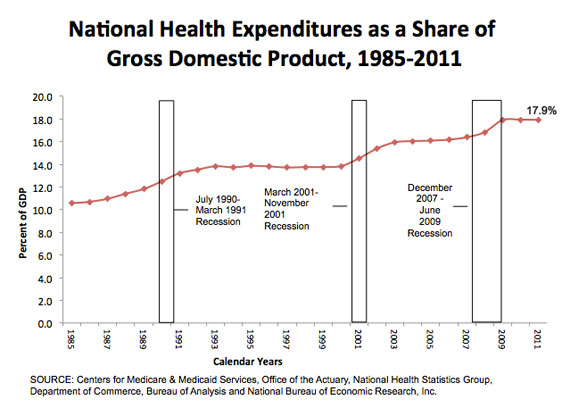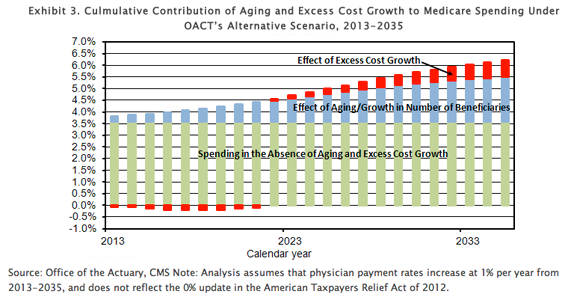Medicare costs continue to be under the microscope as Congress and President Obama gear up for a fight over spending cuts, but a couple of reports released in recent days offer seemingly encouraging news in the decades-long fight to keep health care costs in check. In both cases, though, the positive signals come with plenty of questions.
First, a new analysis by Medicare’s actuaries published in the journal Health Affairs estimates that national health care spending in 2011 grew at a relatively slow 3.9 percent, the third straight year it’s grown at such a modest pace – the slowest in the more than 50 years such data has been tracked.

After gobbling up a rapidly increasing share of our national economy over the past three decades, health-care spending has flattened out over the past few years. It has grown from $2.5 trillion in 2009 to $2.7 trillion in 2011, but as a share of GDP it stayed flat over those three years, at 17.9 percent (see chart below).

Much of the recent stabilization in overall health care spending was due to the effects of the recession, as people who lost their jobs – and the health benefits that came with them – cut back on medical care. From 2007 to 2010, enrollment in private insurance plans dropped by 11.2 million. The report from Medicare’s actuaries includes some signs that those cost-saving effects of the recession began to wear off as Americans returned to the workforce – a great development for the millions who have found new jobs and employer-provided benefits but one that could renew concerns among those tracking overall levels of health care spending.
After three years of declines, enrollment in private insurance plans grew by 1 million, or 0.5 percent in 2011. Medicare’s actuaries say one of the main reasons for that increase was increased coverage of dependents younger than 26 mandated by the Affordable Care Act. (The addition of those younger, healthier beneficiaries did help to drive down growth in private insurers’ spending on benefits per enrollee to 3.2 percent in 2011 from 4.6 percent in 2010.)
At the same time, personal spending on prescription drugs and doctor visits grew more quickly in 2011 than in 2010. (Growth in hospital spending, though, has slowed from 6.7 percent in 2009 to 4.3 percent in 2011, offering hope that some of the cost changes of recent years may prove to be lasting.)
And while overall health care spending grew at about the same rate at the economy, according to the Health Affairs report, Medicare spending grew more quickly, jumping 6.2 percent for 2011 after rising 4.3 percent in 2010.
Spending per beneficiary in 2011 also rose twice as much as it did in 2010, at 3.6 percent compared to 1.8 percent, though that rate of growth was still in line with the rise in nominal GDP. The faster rise was driven by a one-time increase in spending on certain nursing facilities and an increase in spending on Medicare Advantage plans offered by private insurers as well as by patients returning to their doctors’ offices and getting more treatment.
But if the economic recovery raises the prospect that health-care spending will ramp up again, another new report projects that the trajectory for Medicare is being driven more by demographics and the inevitable aging of the population.
Medicare spending is the result of two factors: the amount spent per beneficiary and the number of people receiving benefits. The new HHS report shows that the amount spent per person rose at historically low rates in 2012, also extending the trend from the two previous years. Medicare’s spending per beneficiary grew by 0.4 percent per capita, much more slowly than the 3.4 percent rise in per capita GDP for the year. For the three-year period of 2010 to 2012, Medicare’s cost per beneficiary rose an average 1.9 percent, compared to a 3.2 percent rise in per capita GDP.
This chart from the report, which made the rounds last week, shows the projected growth in Medicare spending out to 2035.

In short, the HHS authors project that most of the increase in Medicare spending will come from the aging population and the growth in the number of beneficiaries (in blue on the chart), with “very little” coming from increased spending per beneficiary above the rate of economic growth (in red). By 2035, that “excess growth” is projected to be about 0.75 percentage points of GDP.
It’s not completely clear how President Obama’s health care reform will affect the current trends. The HHS report credits the health care reform law for reining in rising costs, both last year and over the next decade. It notes that both the Congressional Budget Office and Medicare’s Office of the Actuary have projected that cost increases per beneficiary will grow at about the same pace as per capita GDP over the next decade.
What does this all mean? Broadly, it suggests that there’s still plenty of work to be done in containing long-term Medicare costs. The HHS report says that, “recent reductions in the growth of Medicare per beneficiary spending and projections for the next decade offer strong evidence that we have made great progress.” But even if an improving economy and millions of people newly insured under the Affordable Care Act doesn’t result in tremendous increases in health care spending, the demographic realities are inescapable. Even though spending per beneficiary is projected to grow at or below the rate of per capita GDP, the number of Medicare beneficiaries is projected to grow at approximately 3 percent a year, the HHS report says. The 50 million beneficiaries today will grow to more than 85 million in 2035. “As a result, aggregate Medicare spending will account for a growing share of GDP over the next decade.”





